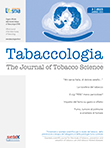|
Rassegna Stampa Scientifica Gennaio 2022
Health effects of tobacco at the global, regional, and national levels: results from the 2019 Global Burden of Disease study Nicotine & Tobacco Research, ntab265. Published: 20 December 2021 Hairong He, Zhenyu Pan, Jiayuan Wu, Chuanyu Hu, Ling Bai, Jun Lyu https://academic.oup.com/ntr/advance-article-abstract/doi/10.1093/ntr/ntab265/6470875
Also:
Cigarette price increases, advertising ban, and pictorial warnings as determinants of youth smoking initiation in Poland https://academic.oup.com/ntr/advance-article-abstract/doi/10.1093/ntr/ntab262/6472807 Are farmers willing to substitute tobacco cultivation? Evidence from Lichuan City, China https://academic.oup.com/ntr/advance-article-abstract/doi/10.1093/ntr/ntab264/6470690 Clearing the air: Conflicts of Interest and the Tobacco Industry’s impact on Indigenous peoples https://academic.oup.com/ntr/advance-article/doi/10.1093/ntr/ntab267/6470893
Note: Indigenous peoples' paper Open Access.
"An open-label, parallel group randomised trial was conducted in Australia between 2014 and 2015, with 1563 adult daily smokers… Conclusion: A free trial of NRT [nicotine replacement therapy] and first generation e-cigarettes and advice on long-term substitution was no better for smoking abstinence than usual care… The findings suggest that providing unflavoured cigalike e-cigarettes without additional support may not increase quitting compared with advice to use standard NRT in a general population of Australians who smoke."
A pragmatic randomised comparative trial of e-cigarettes and other nicotine products for quitting or long-term substitution in smokers Nicotine & Tobacco Research, ntab266. Published: 20 December 2021 Kylie Morphett, Doug Fraser, Ron Borland, Wayne Hall, Natalie Walker, Chris Bullen, Coral Gartner https://academic.oup.com/ntr/advance-article-abstract/doi/10.1093/ntr/ntab266/6470892
Also:
E-Cigarette Dependence in Youth https://academic.oup.com/ntr/advance-article-abstract/doi/10.1093/ntr/ntab268/6479688 Predicting Non-Adherence With Very Low Nicotine Content Cigarettes Among Adults With Serious Mental Illness Who Smoke https://academic.oup.com/ntr/advance-article-abstract/doi/10.1093/ntr/ntab271/6484922 An Analysis of Inpatient Tobacco Use Treatment Transition to Telehealth https://academic.oup.com/ntr/advance-article-abstract/doi/10.1093/ntr/ntab233/6464102
"E-cigarette manufacturers’ schematic playbooks have included strategies for exploiting regulatory loopholes. Tobacco-free nicotine products may threaten ongoing public health efforts to reduce e-cigarette use among adolescents and young adults. We believe these products should be assumed to be as harmful to health as other nicotine products until evidence demonstrates otherwise. There is an urgent need for the FDA [Food & Drug Administration] to assert its regulatory authority over these products, since they are currently unregulated at the federal level."
Perspective Tobacco-free Nicotine — New Name, Same Scheme? N Engl J Med 2021; 385:2406-2408 December 23, 2021 Sam N. Cwalina, Rob McConnell, Neal L. Benowitz, and Jessica L. Barrington-Trimis https://www.nejm.org/doi/full/10.1056/NEJMp2111159
"ENDS [Electronic nicotine delivery systems] and cigarette tax incidence is similar at the state level. Nonetheless, when federal cigarette taxes are considered, the cigarette tax incidence is higher than the tax incidence on closed-system ENDS. The proportion of states that impose value taxes is higher for open systems (65.4%) than for closed systems (46.2%). A value tax base is associated with a 7 percentage point lower tax incidence compared with a specific tax base. Product type further moderates the association between tax base and incidence… Policymakers who aim to prevent youth from using ENDS may consider a value tax base to raise the tax incidence of closed systems—the product type preferred by young people."
Tax incidence of electronic nicotine delivery systems (ENDS) in the USA Tobacco Control Published Online First: 22 December 2021. Ce Shang, Shaoying Ma, Eric N Lindblom https://tobaccocontrol.bmj.com/content/early/2021/12/21/tobaccocontrol-2021-056774
Also:
Transitions to smokeless tobacco use among adult cigarette smokers in the Population Assessment of Tobacco and Health (PATH) Study, Waves 3–5 (2015–2019) https://tobaccocontrol.bmj.com/content/early/2021/12/21/tobaccocontrol-2021-056907 Shifts in preference for Natural American Spirit and associated belief that one’s own cigarette brand might be less harmful than other brands: results from Waves 1–4 of the Population Assessment of Tobacco and Health (PATH) Study (2013–2018) https://tobaccocontrol.bmj.com/content/early/2021/12/23/tobaccocontrol-2021-056985 The Cheyenne River Sioux Tribe resists JUUL’s targeted exploitation https://tobaccocontrol.bmj.com/content/early/2021/12/20/tobaccocontrol-2021-056813
Note: ENDS tax incidence and PATH smokeless transitions papers Open Access.
"The ‘Reporting system of suspected adverse effects (AE) from e-cigarette and refill liquids’ has been developed to monitor the adverse effects on health among electronic cigarette users or non-users. Each MS [Member State] can adjust it on country-level aspects and to make the information flow process even more convenient. If MS or stakeholders have any suggestions to improve the reporting system, they may suggest improvements to the European Commission. The national authorities may consider the contribution of a section of the EU-CEG fee or e-cigarette product taxes for the development and implementation of a reporting system on suspected AE from electronic cigarettes and refill liquids."
Reporting system of suspected adverse effects from electronic cigarettes and refill liquids in Europe Tob Prev Cessat. 2021 Dec 9;7:71. eCollection 2021. Renata Solimini, Caitriona Stack, Kathleen Clifford, Laszlo Bencze, Francisco M Ruiz Dominguez, Constantine Ι Vardavas, Panagiotis Behrakis
Also:
Smoking status on subsequent readmission to hospital: The impact of inpatient brief interventions for smokers
Note: Open Access.
"In this cohort study [using US nationally representative data from the longitudinal Population Assessment of Tobacco and Health Study], daily e-cigarette use was associated with greater odds of cigarette discontinuation among smokers who initially had no plans to ever quit smoking. These findings support the consideration of smokers who are not planning to quit when evaluating the risk-benefit potential of e-cigarettes for smoking cessation in the population."
Association of e-Cigarette Use With Discontinuation of Cigarette Smoking Among Adult Smokers Who Were Initially Never Planning to Quit JAMA Netw Open. 2021;4(12):e2140880. December 28, 2021 Karin A. Kasza, Kathryn C. Edwards, Heather L. Kimmel, Andrew Anesetti-Rothermel, K. Michael Cummings, Raymond S. Niaura, Akshika Sharma, Erin M. Ellis, Rebecca Jackson, Carlos Blanco, Marushka L. Silveira, Dorothy K. Hatsukami, Andrew Hyland Conflict of Interest Disclosures: …Dr Niaura reported serving… as an unpaid grant reviewer for the Foundation for a Smoke Free World [wholly funded by Philip Morris International]. https://jamanetwork.com/journals/jamanetworkopen/fullarticle/2787453
Note: Open Access.
Related coverage:
"Since it was not a randomized trial and participants decided on their own whether or not to begin using e-cigarettes, the potential for unmeasured confounding was significant. Also, the authors noted, they did not examine changes in “quit intentions” as time went on and whether such changes were associated with actual quit rates for smoking. The study relied entirely on participants' self-reports of smoking habits and e-cigarette use. Finally, Kasza and colleagues did not determine how many participants who said they quit smoking later resumed, or quit again after initial relapse." [John Gever, Medpage Today]
Score One for Vapes in Smoking Cessation https://www.medpagetoday.com/pulmonology/smoking/96397 E-cigarettes may help smokers quit even if they don't intend to, study finds https://www.upi.com/Health_News/2021/12/28/e-cigarette-vaping-quit-smoking-study/8241640702435/
"The use of ENDS [electronic nicotine delivery systems] is an increasing trend across the nation among teenagers, young adults, and cigarette smokers who desire to quit smoking. Health care students must learn how to properly educate patients on the dangers of ENDS use and why ENDS should not be used as an alternative to traditional cigarette cessation. Health care students should be fully educated regarding these products so they are able to make informed risk-benefit analysis decisions. A standardized educational intervention for all health care students is needed to enhance the 5A’s method, implement motivational interviewing with empathic listening, and provide more hands-on experiences. "
Commentary The Need for Nationwide Electronic Cigarette Smoking Cessation Curricula Across the Healthcare Spectrum Am J Pharm Educ. 2021 Nov;85(10):8212. Epub 2021 Mar 12. Taylor B Mitchell, Spruha Shah, Lindsay Zink https://www.ajpe.org/content/85/10/8212 https://www.ajpe.org/content/ajpe/85/10/8212.full.pdf
Note: Open Access.
"Multivariate analysis showed that conventional cigarette smokers were independently associated with a better knowledge about e-cigarettes (OR = 1.496, 95CI% = 1.018-2.197, p-value = 0.040). In addition, medical students showed a significantly better knowledge compared to non-medical students (OR = 1.710, 95CI% = 1.326-2.204, p-value = <0.001). In Jordan, e-cigarettes use is less popular compared to other countries. Nonetheless, educational interventions are needed to correct misconceptions about e-cigarettes among young adults."
E-cigarettes use among university students in Jordan: Perception and related knowledge PLoS One. 2021 Dec 31;16(12):e0262090. eCollection 2021. Nour A Al-Sawalha, Basima A Almomani, Enas Mokhemer, Samah F Al-Shatnawi, Roba Bdeir https://journals.plos.org/plosone/article?id=10.1371/journal.pone.0262090
Note: Open Access.
"We present a case of a 31-year-old man who came to our clinic with recurrent stuttering priapism. He had no chronic medical illnesses. He had smoked half a pack of cigarettes per day for the past 6 years but had shifted to vaping e-cigarettes for which he used several e-fluids and brands. His stuttering priapism started approximately 1 week after he began vaping… CONCLUSIONS: The relationship between stuttering priapism and e-cigarettes remains largely unexplored in the literature. Whether e-cigarettes and e-fluids represent a risk factor for priapism in novice e-cigarette smokers warrants further investigation."
Electronic Cigarettes as a Cause of Stuttering Priapism: A Case Report Am J Case Rep. 2021 Dec 30;22:e935716. Abdullah Mousa Alzahrani, Jumanah H Basalelah, Mishal S Alarifi, Shaheed S Alsuhaibani https://www.amjcaserep.com/abstract/index/idArt/935716
Note: Open Access.
"In 1989, PMAI [Philip Morris Asia Inc.] conducted a study of potential Thai customers in which 24% of respondents' lack of availability (i.e., product placement) was one of the main reasons for not smoking PMI's [Philip Morris International's] products. Based on these findings, PMAI engaged in intensive internal efforts to address the placement barrier to gain share. PMAI placed considerable emphasis on "stimulating retail trade acceptance" by making payments to retailers who met agreed upon and contracted product sales targets. PMAI's initial successes incentivizing Thai retailers by essentially buying prime retail space for placement of their brands, to crowd out local and other foreign brands, became the foundation of what evolved into a sophisticated program to make placement highly lucrative for retailers."
Uncovering Philip Morris International's Fundamental Strategies for Product Placement in Thailand: Spotlighting Industry Penetration to Advance the Endgame Asian Pac J Cancer Prev. 2021 Dec 1;22(12):3789-3801. Naowarut Charoenca, Nipapun Kungskulniti, Stephen Hamann, Jeremiah Mock http://journal.waocp.org/?sid=Entrez:PubMed&id=pmid:34967557&key=2021.22.12.3789 http://journal.waocp.org/article_89880_2deede25ab6e3f4b485f8c414b9d5c09.pdf
Note: Open Access.
"Among current smokers (N=39,534), 11.0% reported an increase in smoking, and 12.8% reported a decrease in smoking. Overall, 33.3% reported perceived stress and 3.7% reported depression… Lower education level, living alone, and poor subjective health status were associated with increased smoking. Being a woman and being of older age were associated with decreased smoking. Stress, depression, and anxiety about economic damage due to COVID-19 were more likely to result in increased smoking. Anxiety related to death due to COVID-19 was more likely to result in decreased smoking."
Smoking Behavior Changes during COVID-19 among Korean Adults Am J Health Behav. 2021 Nov 15;45(6):1031-1040. Mi Ah Han, Hae Ran Kim https://www.ingentaconnect.com/content/png/ajhb/2021/00000045/00000006/art00007
"Multivariate analysis was performed on the risk factors for invasion diagnosed by postoperative pathological examination in all cases diagnosed with DCIS [ductal carcinoma in situ] by preoperative biopsy. Number of pack-years was not an independent factor (p=0.349, OR=0.329), but current-smoker status (p=0.006, OR=not calculable) was an independent factor with VAB (p=0.018, OR=0.327). Conclusion: Tobacco components may have an influence on the progression from DCIS to invasive ductal carcinoma."
The Effect of Smoking on Progression from Ductal Carcinoma In Situ to Invasive Ductal Breast Carcinoma: A Retrospective Study Anticancer Res. 2022 Jan;42(1):311-320. Koji Takada, Shinichiro Kashiwagi, Yuka Asano, Wataru Goto, Tamami Morisaki, Masatsune Shibutani, Hiroaki Tanaka, Kosei Hirakawa, Masaichi Ohira https://ar.iiarjournals.org/content/42/1/311
"Of the 24 included studies [from an initial database and manual search that yielded 2050 studies], 46 different factors were identified to be significantly associated with nursing interventions for smoking cessation. The identified factors were grouped into the following four conceptually similar categories: (1) socioeconomic factors, (2) smoking-related factors, (3) motivational factors, and (4) enabling factors and barriers. In the future, nursing interventions for smoking cessation will need to be improved based on the identified factors."
Factors Associated with Nursing Interventions for Smoking Cessation: A Narrative Review Nurs Rep. 2021 Feb 1;11(1):64-74. Meng Li, Keiko Koide, Miho Tanaka, Misaki Kiya, Reiko Okamoto https://www.mdpi.com/2039-4403/11/1/7
Note: Open Access.
Heated tobacco products for smoking cessation and reducing smoking prevalence Cochrane Database of Systematic Reviews Version published: 06 January 2022 Harry Tattan-Birch, Jamie Hartmann-Boyce, Loren Kock, Erikas Simonavicius, Leonie Brose, Sarah Jackson, Lion Shahab, Jamie Brown https://www.cochranelibrary.com/cdsr/doi/10.1002/14651858.CD013790.pub2/full https://www.cochranelibrary.com/cdsr/doi/10.1002/14651858.CD013790.pub2/epdf/full
Note: Open Access.
Related Cochrane Review Authors' Essay:
Heated tobacco: a new review looks at the risks and benefits https://theconversation.com/heated-tobacco-a-new-review-looks-at-the-risks-and-benefits-173110
"After excluding missing data, there were 1,173,646 participants. The adjusted odds ratio of visual impairment in current e-cigarette users compared with never e-cigarette users was 1.34 (95% confidence interval [CI] 1.20-1.48), and in former e-cigarette users was 1.14 (95% CI 1.06-1.22)… Conclusions: Current compared with never e-cigarette usage was associated with a higher odds of visual impairment in the [BRFSS] Behavioral Risk Factor Surveillance System 2016-2018 population, independent of traditional cigarette use."
Association Between E-Cigarette Use and Visual Impairment in the United States American Journal of Ophthalmology VOLUME 235, P229-240, MARCH 01, 2022 Published: September 26, 2021 Abhinav Golla, Angela Chen, Victoria L. Tseng, Samuel Y. Lee, Deyu Pan, Fei Yu, Anne L. Coleman https://www.ajo.com/article/S0002-9394(21)00473-6/fulltext
Related coverage:
E-cigarette toxins may damage users’ sight https://www.thetimes.co.uk/article/e-cigarette-toxins-could-be-damaging-users-vision-hbhdsxmh6
"Both current and ever ENDS [electronic nicotine delivery systems] use increased the probability of transitioning from never to current cigarette use (initiation) and decreased the probability of transitioning from current to non-current use (desistance). Current, but not ever, ENDS use also increased the probability of transitioning from non-current to current use (re-uptake)… Discussion: ENDS use in young adulthood increases the risk for cigarette smoking behaviors across the continuum of uptake and progression. Prevention and cessation efforts targeting both ENDS and cigarette use during young adulthood are needed."
Electronic nicotine delivery systems use predicts transitions in cigarette smoking among young adults Drug Alcohol Depend. 2021 Dec 31;231:109251. Online ahead of print. Alexandra Loukas, C Nathan Marti, Melissa B Harrell https://www.sciencedirect.com/science/article/abs/pii/S0376871621007468
"Our data demonstrated that e-cigarette use altered the oral microbiome in periodontitis patients, enriching members of the Filifactor, Treponema, and Fusobacterium taxa. For patients at the same periodontal disease stage, cigarette smokers and e-cigarette smokers shared more similarities in their oral bacterial composition. E-cigarette smoking may have a similar potential as cigarette smoking at altering the bacterial composition of saliva over time, leading to an increase in the relative abundance of periodontal disease-associated pathogens such as Porphyromonas gingivalis and Fusobacterium nucleatum."
Electronic cigarette use enriches periodontal pathogens Mol Oral Microbiol. 2022 Jan 8. Online ahead of print. Fangxi Xu, Smruti Pushalkar, Ziyan Lin, Scott C Thomas, Julia Kishanie Persaud, Maria A Sierra, Mridula Vardhan, Rebeca Vasconcelos, Adenike Akapo, Yuqi Guo, Terry Gordon, Patricia M Corby, Angela R Kamer, Xin Li, Deepak Saxena https://onlinelibrary.wiley.com/doi/10.1111/omi.12361
"We followed 45 923 never-smoking women, aged 34-70 years [in the Norwegian Women and Cancer Study], who completed a baseline questionnaire between 1991 and 2007 through linkages to national registries through December 2018… During a mean follow-up of 19.8 (6.8) years, 2185 women developed invasive breast cancer, confirmed by histology. Women exposed to SHS [secondhand smoke] from parents during childhood had an 11% higher (95% CI: 1.02-1.22) risk of breast cancer compared with those who were not… Conclusions: Our results suggest that 1 in 14 breast-cancer cases could have been avoided in the absence of SHS exposure from parents during childhood in a population of never-smoking women. The cancer burden attributable to SHS may be underestimated."
Never-smokers and the fraction of breast cancer attributable to second-hand smoke from parents during childhood: the Norwegian Women and Cancer Study 1991-2018 Int J Epidemiol. 2022 Jan 6;50(6):1927-1935. Inger T Gram, Arne Bastian Wiik, Eiliv Lund, Idlir Licaj, Tonje Braaten https://academic.oup.com/ije/article/50/6/1927/6333578
Also:
Maternal smoking and smokeless tobacco use during pregnancy and offspring development: sibling analysis in an intergenerational Swedish cohort https://academic.oup.com/ije/article/50/6/1840/6275394
Note: Open Access.
"Compared with cigarette smokers, ST [smokeless tobacco] users had significantly higher concentrations of total nicotine equivalents (TNE) but lower concentrations of inflammatory (high-sensitivity C-reactive protein, interleukin-6, intercellular adhesion molecule, fibrinogen) and oxidative stress (8-isoprostane) biomarkers (all p < .05)… Despite having higher levels of nicotine and compared with exclusive cigarette smokers, exclusive ST users (including those who were former cigarette smokers) had significantly lower concentrations of inflammatory and oxidative stress biomarkers, comparable to levels observed among never tobacco users."
Associations of Smokeless Tobacco Use With Cardiovascular Disease Risk: Insights From the Population Assessment of Tobacco and Health Study Nicotine & Tobacco Research, ntab258. Published: 06 January 2022 Mary Rezk-Hanna, Umme Shefa Warda, Andrew C Stokes, Jessica Fetterman, Jian Li, MD, Paul M Macey, Muhammad Darawad, Yeonsu Song, Ziyad Ben Taleb, Mary-Lynn Brecht, Neal L Benowitz https://academic.oup.com/ntr/advance-article-abstract/doi/10.1093/ntr/ntab258/6499417
Related PR:
Switching to smokeless tobacco associated with lower cardiovascular disease risk in smokers
"Studies have revealed inconclusive results using agents including chewing tobacco and e-cigarettes to quit smoking and have demonstrated continued use of these agents. Many smoking harm reduction agents pose other health risks not found in traditional tobacco smoking. Given these limitations, efforts should focus on promoting nicotine replacement therapy, and other pharmacologic agents with a better chance of producing sustained smoking cessation. To address the harmful nature of many tobacco replacement products, public health should focus on regulating these alternatives with the same stringency as tobacco, and social marketing efforts should target evidence-based and safer pharmaceutical grade or behavioural alternatives."
Harm reduction in tobacco control: where do we draw the line? J Public Health Policy. 2022 Jan 8. Online ahead of print. Mohammed Al-Hamdani, Eden Manly https://link.springer.com/article/10.1057%2Fs41271-021-00327-5
Also:
Association of preferred flavorings and device type with box or pack purchase behavior of electronic nicotine delivery systems in the United States https://link.springer.com/article/10.1057%2Fs41271-021-00326-6
"The major U.S. tobacco companies directed the bulk of their vast spending on the retail environment since 1988. Moreover, they have dramatically shifted their marketing strategies within the retail category from cigarette advertising before 2003 to customer-directed price discounts since then. This shift may imply a change in focus from recruiting new smokers to retaining current smokers, in response to tax increases and government regulations. Accordingly, restrictions on price-related promotions in retail and non-tax strategies should be implemented to counter tobacco companies’ marketing efforts in retail."
Trends in Cigarette Marketing Expenditures, 1975-2019: An Analysis of Federal Trade Commission Cigarette Reports Nicotine & Tobacco Research, ntab272. Published: 05 January 2022 Haijing Ma, Alexandria E Reimold, Kurt M Ribisl https://academic.oup.com/ntr/advance-article-abstract/doi/10.1093/ntr/ntab272/6497947
"Barriers to supporting smoking cessation or temporary abstinence in mental health settings mainly fell within the domains: environmental context and resources (e.g. MHPs [mental healthcare professionals'] lack of time); knowledge (e.g. interactions around smoking that did occur were ill-informed); social influences (e.g. smoking norms within social network), and intentions (e.g. MHPs lack positive intentions to deliver support)."
A systematic review of mental health professionals, patients and carers’ perceived barriers and enablers to supporting smoking cessation in mental health settings Nicotine & Tobacco Research, ntac004. Published: 08 January 2022 Lisa Huddlestone, Emily Shoesmith, Jodi Pervin, Fabiana Lorencatto, Jude Watson, Elena Ratschen https://academic.oup.com/ntr/advance-article/doi/10.1093/ntr/ntac004/6501336
Note: Open Access.
"At baseline, smokers were more likely to be lonely (coef.=0·111, 95% CI 0·025 – 0·196) and socially isolated than non-smokers, having less frequent social interactions with family and friends (coef.= 0·297, 95%CI 0·148 – 0·446), less frequent engagement with community and cultural activities (coef.= 0·534, 95%CI 0·421 – 0·654), and being more likely to live alone (Odds Ratio =1·400, 95%CI 1·209 – 1·618)… Interpretation: Smoking is associated with the development of increasing social isolation and loneliness in older adults, suggesting smoking is detrimental to aspects of psychosocial health. The idea that smoking might be prosocial appears a misconception."
Relationship of smoking with current and future social isolation and loneliness: 12-year follow-up of older adults in England Lancet Regional Health Europe VOLUME 14, 100302, MARCH 01, 2022 Published: January 02, 2022 Keir EJ Philip. Feifei Bu, Michael I Polkey, Jamie Brown, Andrew Steptoe, Nicholas S Hopkinson, Daisy Fancourt https://www.thelancet.com/journals/lanepe/article/PIIS2666-7762(21)00288-X/fulltext https://www.thelancet.com/action/showPdf?pii=S2666-7762%2821%2900288-X
Note: Open Access.
Related PR:
New findings suggest smoking increases social isolation and loneliness https://medicalxpress.com/news/2022-01-social-isolation-loneliness.html
"Regional trends in longitudinal consumption patterns identify stable or decreasing consumption throughout Northern, Western and Southern European countries, while Eastern and Southeastern European countries experienced much greater instability. The 11 emergent classes of historical cigarette consumption trajectories were also regionally clustered, including a distinctive inverted U or sine wave pattern repeatedly emerging from former Soviet and Southeastern European countries."
Classifying European cigarette consumption trajectories from 1970 to 2015 Tob Control. 2022 Jan 7;tobaccocontrol-2021-056627. Online ahead of print. Mathieu Jp Poirier, Gigi Lin, Leah K Watson, Steven J Hoffman https://tobaccocontrol.bmj.com/content/early/2022/01/06/tobaccocontrol-2021-056627
Also:
Exposure of 4-year to 24-year olds to tobacco imagery on prime-time Chilean television https://tobaccocontrol.bmj.com/content/early/2022/01/04/tobaccocontrol-2021-056735 Comprehensive Dutch market data analysis shows that e-liquids with nicotine salts have both higher nicotine and flavour concentrations than those with free-base nicotine https://tobaccocontrol.bmj.com/content/early/2022/01/04/tobaccocontrol-2021-056952
Note: Open Access.
"Quitting smoking at or around diagnosis was significantly associated with improved overall survival (SRR 0.80, 95%CI 0.73-0.96), consistently among patients with non-small cell LC [lung cancer] (SRR 0.79, 95% CI 0.67-0.93, n studies = 7), small cell LC (SRR 0.75, 95% CI 0.57-0.99, n studies = 4), or LC of both or unspecified histological type (SRR 0.81, 95% CI 0.68-0.96, n studies = 6)… Treating physicians should educate LC patients about the benefits of quitting smoking even after diagnosis and provide them with the necessary smoking cessation support."
Quitting smoking at or around diagnosis improves the overall survival of lung cancer patients: a systematic review and meta-analysis Journal of Thoracic Oncology Published: January 04, 2022 Saverio Caini, Marco Del Riccio, Virginia Vettori, Vieri Scotti, Chiara Martinoli, Sara Raimondi, Giulio Cammarata, Domenico Palli, Marco Banini, Giovanna Masala, Sara Gandini https://www.jto.org/article/S1556-0864(21)03404-3/pdf
Related coverage:
Smoking cessation after cancer diagnosis associated with improved survival https://medicalxpress.com/news/2022-01-cessation-cancer-diagnosis-survival.html
"It is well recognized that smoking is associated with suicidal ideation, suicide attempts, suicide death and a contributing factor in the pathophysiology of suicide. The author highlights the evidence that suggests that the COVID-19 pandemic has led to increased tobacco consumption as smokers use more tobacco to cope with pandemic-related stress, anxiety, depression and loneliness. Smoking will have significant psychobiological effects resulting in enhanced impulsivity and aggression which will be compounded by in particular the brain-related symptoms."
The Long-COVID Syndrome: smoking and enhanced suicide risk QJM. 2022 Jan 5;114(11):765. Seamas C Donnelly https://academic.oup.com/qjmed/article-abstract/114/11/765/6498183
Cigarette prices and smoking among youth in 16 African countries: Evidence from the Global Youth Tobacco Survey Nicotine & Tobacco Research, ntac017. Published: 17 January 2022 Samantha Filby, Corne van Walbeek https://academic.oup.com/ntr/advance-article/doi/10.1093/ntr/ntac017/6509071
Also:
Think Globally, Act Locally: Local Tobacco Control https://academic.oup.com/ntr/advance-article/doi/10.1093/ntr/ntac015/6509036
Note: Open Access.
"We analysed data from 134 909 participants from 21 countries followed up for a median of 11·3 years in the Prospective Urban Rural Epidemiology (PURE) cohort study; 9711 participants with myocardial infarction and 11 362 controls from 52 countries in the INTERHEART case-control study; and 11 580 participants with stroke and 11 331 controls from 32 countries in the INTERSTROKE case-control study… In PURE, the adjusted hazard ratio (HR) for the composite outcome in current smokers (vs never smokers) was higher in HICs [high-income countries] (HR 1·87, 95% CI 1·65-2·12) than in MICs [middle-income countries] (1·41, 1·34-1·49) and LICs [low-income countries] (1·35, 1·25-1·46; interaction p<0·0001). Similar patterns were observed for each component of the composite outcome in PURE, myocardial infarction in INTERHEART, and stroke in INTERSTROKE. The median levels of tar, nicotine, and carbon monoxide displayed on the cigarette packs from PURE HICs were higher than those on the packs from MICs."
Variations in risks from smoking between high-income, middle-income, and low-income countries: an analysis of data from 179 000 participants from 63 countries Lancet Glob Health. 2022 Feb;10(2):e216-e226. Thirunavukkarasu Sathish, Koon K Teo, Philip Britz-McKibbin, Biban Gill, Shofiqul Islam, Guillaume Paré, Sumathy Rangarajan, MyLinh Duong, Fernando Lanas, Patricio Lopez-Jaramillo, Prem K Mony, Lakshmi Pinnaka, Vellappillil Raman Kutty, Andres Orlandini, Alvaro Avezum, Andreas Wielgosz, Paul Poirier, Khalid F Alhabib, Ahmet Temizhan, Jephat Chifamba, Karen Yeates, Iolanthé M Kruger, Rasha Khatib, Rita Yusuf, Annika Rosengren, Katarzyna Zatonska, Romaina Iqbal, Weida Lui, Xinyue Lang, Sidong Li, Bo Hu, Antonio L Dans, Afzal Hussein Yusufali, Ahmad Bahonar, Martin J O’Donnell, Martin McKee, Salim Yusuf https://www.thelancet.com/journals/langlo/article/PIIS2214-109X(21)00509-X/fulltext https://www.thelancet.com/action/showPdf?pii=S2214-109X%2821%2900509-X
Related Lancet Glob Health Comment:
Strengthening tobacco control must remain a global health priority https://www.thelancet.com/journals/langlo/article/PIIS2214-109X(21)00571-4/fulltext https://www.thelancet.com/action/showPdf?pii=S2214-109X%2821%2900571-4
Note: Open Access.
"In 2020, an estimated 69.9% of U.S. adults supported pictorial warnings, 9.1% opposed, and 20.9% neither supported nor opposed them… Implications: While public support for pictorial warnings on cigarette packages is high in the U.S., it may increase further after policy implementation and be strengthened by utilizing information campaigns that convey the evidence that pictorial warnings are an effective public health strategy."
Public support for cigarette pack pictorial health warnings among U.S. adults: A cross-sectional analysis of the 2020 Health Information National Trends Survey Nicotine & Tobacco Research, ntab263. Published: 21 January 2022 Annette R Kaufman, Heather D’Angelo, Anna Gaysynsky, Andrew B Seidenberg, Robert E Vollinger, Kelly Blake https://academic.oup.com/ntr/advance-article-abstract/doi/10.1093/ntr/ntab263/6513367
"Across survey waves, the percentage of participants in provinces with POS [point-of-sale] bans established for more than 24 months increased from 5.0% to 95.8%. There was no association between POS bans and quit attempts for provinces with bans in place for 0–24 months or more than 24 months, respectively (adjusted relative risk (aRR)=0.99, 95% CI: 0.89 to 1.10; 1.03, 95% CI: 0.88 to 1.20). However, we found a differential impact of POS bans on quit attempts by sex, whereby bans were more effective for women than men for bans of 0–24 months… Conclusion: POS bans are associated with increased smoking cessation overall and more quit attempts among women than men."
Differential impact of the Canadian point-of-sale tobacco display bans on quit attempts and smoking cessation outcomes by sex, income and education: longitudinal findings from the ITC Canada Survey Tobacco Control Published Online First: 11 January 2022. Bukola Usidame, Yanmei Xie, James F Thrasher, Paula Lozano, Michael R Elliott, Geoffrey T Fong, Nancy L Fleischer https://tobaccocontrol.bmj.com/content/early/2022/01/16/tobaccocontrol-2021-056805
"The results suggest that perception of ENDS [electronic nicotine delivery systems] as less harmful than cigarettes significantly decreased from 54.3% at Wave 1 (2013) to 30.4% at Wave 4 (2018) (P < 0.001). Perception of ENDS as no or little harm decreased from 35.9% at Wave 1 to 16.9% at Wave 4 (P < 0.001)… Conclusions: Our study showed that US adolescents have become more aware of ENDS harms over time. These changes in harm perception were less noticeable among those who were males, did not have positive tobacco-related attitudes, had smoke-free home rules, ever used ENDS or alcohol, and lived with someone who used tobacco. Such results not only highlight some of the common patterns shared with other tobacco products but also underscore the unique factors specific to ENDS."
Changes in harm perception of ENDS and their predictors among US adolescents: Findings from the population assessment of tobacco and health (PATH) study, 2013-2018 Prev Med. 2022 Jan 20;106957. Online ahead of print. Wei Li, Olatokunbo Osibogun, Tan Li, Matthew T Sutherland, Wasim Maziak https://linkinghub.elsevier.com/retrieve/pii/S0091743522000056
"Among the total sample [of youth in Connecticut and California (N = 10,482; ages 13-24)], combustible tobacco use was associated with any e-cigarette device use (vs. no e-cigarette use) in the pooled analysis across all studies. Among past-month e-cigarette users, combustible tobacco use across all studies was 15.8%- 61.5%. Pooled associations among past-month e-cigarette users showed that using disposable devices (vs. pods; AOR=2.83, 95% CI: 1.73-4.61) and multiple devices most frequently (vs. pods; AOR=2.13, 95% CI: 1.16-3.90) was associated with greater odds of combustible tobacco use."
E-cigarette device type and combustible tobacco use: Results from a pooled analysis of 10,482 youth Drug Alcohol Depend. 2022 Jan 11;232:109279. Online ahead of print. Grace Kong, Benjamin W Chaffee, Ran Wu, Suchitra Krishnan-Sarin, Feifei Liu, Adam M Leventhal, Rob McConnell, Jessica Barrington-Trimis https://www.sciencedirect.com/science/article/abs/pii/S0376871622000163
"Both cross-sectional (Cohort 1 vs Cohort 2) and prospective (pre-post Tobacco 21 in Cohort 1) analyses indicated a slight decline in most tobacco use from 2016 to 2018, but e-cigarette use more than doubled during the same period. Students enrolled throughout the transition to Tobacco 21 (Cohort 1) perceived little effect of Tobacco 21 on peer use… Conclusions: Tobacco 21 was associated with reductions in combustible and smokeless tobacco use, but its impact was not sufficient to curb the surge in e-cigarette use."
Tobacco 21's Impact Amid the E-Cigarette Surge Public Health Rep. 2022 Jan 21;333549211061772. Online ahead of print. Megan E Roberts, Brittney Keller-Hamilton, Andreas A Teferra https://journals.sagepub.com/doi/10.1177/00333549211061772
"In a multivariable adjusted logistic regression model, e-cigarette use was significantly associated with male gender (OR:3.2; 95% CI:1.5–6.7) and cigarette smoking (OR:14.7; 95% CI:5.5–39.0 for daily smoking)… In addition, the prevalence of overweight/obesity was higher among e-cigarette users compared to non-users (36.7% vs. 22.3% with BMI≥25 kg/m2)… Attention should be given to respiratory symptoms among e-cigarette users, although our results may be explained by the concurrent use of conventional cigarettes, as the group of exclusive e-cigarette users were too small to allow firm conclusions."
Predictors of electronic cigarette use and its association with respiratory health and obesity in young adulthood in Sweden; findings from the population-based birth cohort BAMSE Environ Res. 2022 Jan 20;112760. Online ahead of print. Shanzina Iasmin Sompa, Anna Zettergren, Sandra Ekström, Swapna Upadhyay, Koustav Ganguly, Antonios Georgelis, Petter Ljungman, Göran Pershagen, Inger Kull, Erik Melén, Lena Palmberg, Anna Bergström https://www.sciencedirect.com/science/article/pii/S0013935122000871
Note: Open Access.
"Overall, 58% support a comprehensive flavoured tobacco product sales ban, and 59% support a flavoured e-cigarette product sales ban. In addition, 81% support limiting the amount of nicotine in e-cigarette pods, and 91% support mandating vaping health warning signs at local retailers. Flavour bans were more likely to be backed by women, seniors, Latinos, non-smokers and non-vapers. Participants who believe minors have more access to flavoured products had greater odds of supporting all policies. Those aware of the association between e-cigarettes and lung injury were more likely to support non-ban policies. Participants who believe e-cigarettes help to reduce tobacco use or e-cigarettes are relatively less addictive were less likely to support bans."
Public support for policies to regulate flavoured tobacco and e-cigarette products in rural California Tob Control. 2022 Jan 21;tobaccocontrol-2021-057031. Online ahead of print. Denise Diaz Payán, Nancy J Burke, Jamie Persinger, Juliette Martinez, Lisa Jones Barker, Anna V Song https://tobaccocontrol.bmj.com/content/early/2022/01/20/tobaccocontrol-2021-057031
Note: Open Access.
"An online survey and discrete choice experiment on a nationally-representative sample of adult smokers in the US who reported low interest in quitting (n=2000)… Participants formed two latent classes: (1) those with very strong preferences for their own cigarettes; and (2) those whose choices were more responsive to policies. The latter group’s choices were only somewhat responsive to menthol cigarette bans and taxes; the former group’s choices were unresponsive. Conclusions: The policies studied seem unlikely to encourage harm reduction for individuals with little interest in quitting smoking."
Harm reduction for smokers with little to no quit interest: can tobacco policies encourage switching to e-cigarettes? Tobacco Control Published Online First: 19 January 2022. John Buckell, Lisa M Fucito, Suchitra Krishnan-Sarin, Stephanie O'Malley, Jody L Sindelar https://tobaccocontrol.bmj.com/content/early/2022/01/18/tobaccocontrol-2021-057024
Also:
E-cigarette vending machines: a new access channel for youth in Guatemala City https://tobaccocontrol.bmj.com/content/early/2022/01/20/tobaccocontrol-2021-057102 Diffusion of smoke-free policies at outdoor sports clubs in the Netherlands https://tobaccocontrol.bmj.com/content/early/2022/01/16/tobaccocontrol-2021-057022
"Findings suggest FCVs [flavour capsule variants] are marketed using a mix of strategies, particularly characterised by product innovation, timing market launches around tobacco policies, point-of-sale advertising and packaging to communicate a high-tech, customisable and flavourful product."
Marketing of flavour capsule cigarettes: a systematic review Tobacco Control Published Online First: 18 January 2022. Christina N Kyriakos, Mateusz Zygmunt Zatoński, Filippos T Filippidis https://tobaccocontrol.bmj.com/content/early/2022/01/17/tobaccocontrol-2021-057082
"The growing body of evidence surrounding e-cigarette exposure indicates that chronic e-cigarette use will result in changes to the pulmonary environment. In vivo and in vitro models of exposure consistently show dysregulated inflammatory cytokine output, potentially driven by oxidative stress, and disproportionate and ineffective pathogen responses. These changes reflect some elements of the immunopathogenesis of smoking and COPD [chronic obstructive pulmonary disease], although directly comparable studies are limited thus far."
Predicting the pulmonary effects of long-term e-cigarette use: are the clouds clearing? European Respiratory Review 2022 31: 210121 Published online January 12, 2022. Lauren C. Davis, Elizabeth Sapey, David R. Thickett, Aaron Scott https://err.ersjournals.com/content/31/163/210121 https://err.ersjournals.com/content/errev/31/163/210121.full.pdf
Note: Open Access.
"Our stable isotope tracing experiments provide further evidence that thermal decomposition of vegetable glycerin in the e-cigarette solvent leads to generation of acrolein and glycidol. This suggests that the adverse health effects of e-cigarettes may be attributable in part to these reactive compounds formed through the process of aerosolizing nicotine."
Electronic Cigarette Solvents, JUUL E-Liquids, and Biomarkers of Exposure: In Vivo Evidence for Acrolein and Glycidol in E-Cig-Derived Aerosols Chem. Res. Toxicol. 2022, XXXX, XXX, XXX-XXX Publication Date: January 19, 2022 Pawel Lorkiewicz, Rachel Keith, Jordan Lynch, Lexiao Jin, Whitney Theis, Tatiana Krivokhizhina, Daniel Riggs, Aruni Bhatnagar, Sanjay Srivastava, and Daniel J. Conklin https://pubs.acs.org/doi/10.1021/acs.chemrestox.1c00328
Note: Open Access.
Also:
Characterizing the Chemical Landscape in Commercial E-Cigarette Liquids and Aerosols by Liquid Chromatography–High-Resolution Mass Spectrometry https://pubs.acs.org/doi/abs/10.1021/acs.chemrestox.1c00253
"These new policies are designed to counteract access, addiction, and promotion of smoked tobacco and seem both justified and proportionate to the level of associated risk to both individuals and society. The effect of the new measures in the context of a comprehensive tobacco control strategy requires detailed evaluation, but as the world’s most ambitious tobacco control plan to date, its success or failure will provide lessons for us all."
Editorials New Zealand’s bold new tobacco control programme BMJ 2022;376:o62 (Published 18 January 2022) Sanjay Agrawal https://www.bmj.com/content/376/bmj.o62.full
"From the 630,278 critically ill trauma patients identified, 116,068 (18.4%) were current cigarette smokers. Critically ill trauma smokers, compared to non-smokers, had a higher rate of pneumonia (7.8% vs. 6.9%, p < 0.001) and lower mortality rate (4.0% vs. 8.0%, p < 0.001)… Conclusion: Critically ill trauma smokers had a decreased associated mortality risk compared to non-smokers possibly due to biologic adaptations such as increased oxygen delivery developed from smoking. Future basic science and translational studies are needed to pursue potential novel therapeutic benefits without the deleterious long-term side effects of smoking."
Cigarette Smoking is Associated with Decreased Mortality in Critically Ill Trauma Patients Shock. 2022 Jan 20. Online ahead of print. Areg Grigorian, Catherine M Kuza, Patrick T Delaplain, Mandeep Singh, Oscar Hernandez Dominguez, Trung Vu, Michael P Kim, Jeffry Nahmias
"Consumer demands and innovation have led to an increasingly diverse range of nicotine delivery systems, driven by a desire to reduce risk associated with traditional combustible cigarettes. This speed of change provides a mandate for rapid new product assessment. We have used the validated technology ToxTracker®, to assess biomarkers of DNA damage, protein misfolding, oxidative and cellular stress, across the categories of cigarette (1R6F), tobacco heating product (THP1.4) and electronic cigarette (ePen 3)."
Application of ToxTracker for the toxicological assessment of tobacco and nicotine delivery products Toxicol Lett. 2022 Jan 19;S0378-4274(22)00016-9. Online ahead of print. David E Smart, Stela Bozhilova, Fabio Miazzi, Linsey E Haswell, M D Gaca, David Thorne, Damien Breheny Competing interests All authors are (or were at the time of study conduct) employees of British American Tobacco (BAT). The work was fully funded by BAT. ePen 3 is manufactured and marketed by BAT. https://www.sciencedirect.com/science/article/pii/S0378427422000169
Note: Open Access tobacco industry research.
Symptoms COVID 19 Positive Vapers Compared to COVID 19 Positive Non-vapers Journal of Primary Care & Community Health First Published January 5, 2022 David D. McFadden, Shari L. Bornstein, Robert Vassallo, Bradley R. Salonen, Mohammed Nadir Bhuiyan, Darrell R. Schroeder, Ivana T. Croghan https://journals.sagepub.com/doi/full/10.1177/21501319211062672 https://journals.sagepub.com/doi/pdf/10.1177/21501319211062672
Note: Open Access.
Related PR:
E-cigarette users who test positive for COVID-19 are more likely to experience COVID-19 symptoms https://www.eurekalert.org/news-releases/940130 https://www.sciencedaily.com/releases/2022/01/220113151402.htm
"We conducted a web-based cross-sectional study of a representative sample of 6,003 Italian adults during the strictest phase of the Covid-19 lockdown (April–May 2020)… E-cigarettes and HTPs [heated tobacco products] played little role as smoking cessation tools for hardcore smokers but rather provided opportunities for young never smokers to engage in socially acceptable activities, perhaps reflecting the obstacles they faced in obtaining other addictive substances during confinement."
Use of electronic cigarettes and heated tobacco products during the Covid-19 pandemic Scientific Reports volume 12, Article number: 702 (2022) Published: 13 January 2022 Silvano Gallus, Chiara Stival, Giulia Carreras, Giuseppe Gorini, Andrea Amerio, Martin McKee, Anna Odone, Piet A. van den Brandt, Lorenzo Spizzichino, Roberta Pacifici & Alessandra Lugo https://www.nature.com/articles/s41598-021-04438-7 https://www.nature.com/articles/s41598-021-04438-7.pdf
Note: Open Access.
"The proportion of registered callers with an expressed intent to quit tobacco increased by 1.73 times during pandemic (16.7% versus 9.6%). Health concerns were cited as the major reason (93.25%) to quit tobacco in 2020 as compared to 2019 (88.02%). Cough (28.50%) and psychological difficulties (14.20%) were reported significantly more by RCs [registered callers] in 2020… Conclusion: The pandemic resulted in a greater intent to quit among registered callers to the quitline. However, awareness about the quitline services as well as other tobacco cessation services needs to be expanded to reach more tobacco users."
Impact of Covid -19 on caller characteristics and quit rates: An experience from regional tobacco Quitline from India Nicotine & Tobacco Research, ntac013. Published: 12 January 2022 Pradeep Kumar, Pratima Murthy, R P Lohit, Sudarshan Hegde, Prabhat Chand, Lakshmanan Sethuraman https://academic.oup.com/ntr/advance-article/doi/10.1093/ntr/ntac013/6505271
Also:
Changes in Smoking Behavior, Stress, and Sleep Duration among Israeli Hospital Workers during the COVID-19 pandemic: A Cross-Sectional Study https://academic.oup.com/ntr/advance-article-abstract/doi/10.1093/ntr/ntac014/6507354
Note: Indian Quitline paper Open Access.
"Prevalence of secondhand nicotine vape increased from 11.7% to 15.6% during the study period in this population [in the prospective Southern California Children Health Study cohort]. Prevalence of wheeze, bronchitic symptoms and shortness of breath ranged from 12.3% to 14.9%, 19.4% to 26.0% and 16.5% to 18.1%, respectively, during the study period. Associations of secondhand nicotine vape exposure with bronchitic symptoms (OR 1.40, 95% CI 1.06 to 1.84) and shortness of breath (OR 1.53, 95% CI 1.06 to 2.21) were observed after controlling for vaping, active and passive exposure to tobacco or cannabis, and demographic characteristics (age, gender, race/ethnicity and parental education)."
Secondhand nicotine vaping at home and respiratory symptoms in young adults Thorax Published Online First: 10 January 2022. Talat Islam, Jessica Braymiller, Sandrah P Eckel, Feifei Liu, Alayna P Tackett, Meghan E Rebuli, Jessica Barrington-Trimis, Rob McConnell https://thorax.bmj.com/content/early/2022/01/05/thoraxjnl-2021-217041 https://thorax.bmj.com/content/thoraxjnl/early/2022/01/05/thoraxjnl-2021-217041.full.pdf
Note: Open Access.
Related coverage & PR:
Exposure to second-hand nicotine from VAPING doubles risk of young adults developing a wheeze, study finds Secondhand nicotine vaping at home linked to heightened risk of bronchitic symptoms in young adults Secondhand nicotine vaping at home may increase risk of bronchitic symptoms in young adults https://www.eurekalert.org/news-releases/939447
"Disagreement that companies lie about harm (adjusted odds ratio (aOR)= 1.94, 95% CI: 1.43-2.63) and companies want young people to vape (aOR=1.72, 95% CI: 1.36-2.17) was associated with increased odds of current use. Belief that e-cigarette and cigarette companies were different entities was associated with increased odds of current use (aOR=1.45, 95% CI: 1.12-1.88)… Conclusion: Similar to cigarettes, e-cigarette industry beliefs were associated with current use among young people. Highlighting e-cigarettes' connection to Big Tobacco may be an important strategy to prevent youth and young adult e-cigarette use."
Associations of e-cigarette industry beliefs and e-cigarette use and susceptibility among youth and young adults in the United States Drug Alcohol Depend. 2021 Oct 27;231:109126. Online ahead of print. Alison F Cuccia, Minal Patel, Elexis C Kierstead, W Douglas Evans, Barbara A Schillo https://www.sciencedirect.com/science/article/abs/pii/S0376871621006219
Also:
Responses to e-cigarette health messages among young adult sexual minoritized women and nonbinary people assigned female at birth: Assessing the influence of message theme and format https://www.sciencedirect.com/science/article/abs/pii/S0376871621007444
"The top five most important predictors of perceived success in vaping-assisted smoking cessation were more positive experiences measured by the Vaping Experiences Score (100%), less previously failed quit attempts by vaping (39.0%), younger age (21.9%), having vaped 100 times (16.8%), and vaping shortly after waking up (15.8%). Our findings provide strong statistical evidence that shows better vaping experiences are associated with greater perceived success in smoking cessation by vaping. Furthermore, our study confirmed the strength of machine learning techniques in vaping-related outcomes research based on observational data."
Predictors of perceived success in quitting smoking by vaping: A machine learning approach PLoS One. 2022 Jan 14;17(1):e0262407. eCollection 2022. Rui Fu, Robert Schwartz, Nicholas Mitsakakis, Lori M Diemert, Shawn O'Connor, Joanna E Cohen https://journals.plos.org/plosone/article?id=10.1371/journal.pone.0262407
Note: Open Access.
Hopkinson: Yes: "Medically licensed devices have the potential to be more effective than consumer devices because they can be made available in strengths greater than those permitted for consumer products (that is, containing more than 20 mg/mL nicotine). A Cochrane Collaboration systematic review already supports existing e-cigarettes as a smoking cessation aid, as does recently updated guidance from the National Institute for Health and Care Excellence."… Vestbo, Bush, Grigg: No: "There is already enough nicotine addiction… No country in the world other than the UK has licensed e-cigarettes as drugs, and for good reasons. E-cigarettes as an aid to smoking cessation have not been endorsed by a single major respiratory or paediatric scientific society because their effectiveness in smoking cessation is unproved—and remarkably poorly studied… Many e-cigarettes are produced and marketed by companies owned by the tobacco industry—an industry with a history of lying to the public and spending fortunes on marketing, including to teenagers."
Head To Head Should e-cigarettes be licensed as medicines? BMJ 2022;376:n2912 (Published 12 January 2022) Nicholas S Hopkinson, Jørgen Vestbo, Andrew Bush, Jonathan Grigg https://www.bmj.com/content/376/bmj.n2912 https://www.bmj.com/content/bmj/376/bmj.n2912.full.pdf
Note: Open Access.
Related PR:
Should e-cigarettes be licensed as medicines? https://scienmag.com/should-e-cigarettes-be-licensed-as-medicines/
"Initiation rates were 5.9% for nicotine vaping and 8.6% for cannabis vaping, at 12-month follow-up overall [in 79 public and private schools in Texas]. Higher perceived parental knowledge was associated with lower odds of nicotine vaping initiation at 6 months (adj OR: .69; 95% CI: .50-.93) and 12 months (adj OR: .68; 95% CI: .50-.92)… Conclusion: E-cigarette prevention efforts directed at adolescents should incorporate parent engagement strategies as a method of increasing actual and perceived parental knowledge of their child's location, activities and peer groups."
Perceived Parental Knowledge Reduces Risk for Initiation of Nicotine and Cannabis Vaping: A Longitudinal Study of Adolescents Am J Health Promot. 2022 Jan 14;8901171211061941. Online ahead of print. Dale S Mantey, Stephanie L Clendennen, Andrew E Springer, Melissa B Harrell https://journals.sagepub.com/doi/10.1177/08901171211061941
"One must ask if we should be enquiring about a patient's social history from a younger age? It is not standard practice to ask those below 16 if they use nicotine products; this trend may change that. As healthcare professionals, we have a pivotal role in educating our patients in order to prevent an addiction which may be very difficult to overcome once established."
Upfront Letter Vaping: should we be worried? Br Dent J. 2022 Jan;232(1):5-6. O Mudhar https://www.nature.com/articles/s41415-022-3839-0 https://www.nature.com/articles/s41415-022-3839-0.pdf
Note: Open Access.
"In this study, we have compared two distinct systems; the modified Vitrocell VC10 and Borgwaldt LM4E designed to deliver undiluted e-cigarette aerosol. We assessed the cytotoxicity response of 3D reconstituted lung tissue (MucilAir) exposed to undiluted aerosol from ePen3 (closed modular e-cigarette) using these two exposure systems… The parity of responses between the systems in generated undiluted aerosol has allowed us to compare back to previously published eBox data, irrespective of aerosol generating system and MucilAir donor, showing how evolution from open systems to podmod e-cigarette design can make a step change in the cytotoxicity profile of the product."
A 3D in vitro comparison of two undiluted e-cigarette aerosol generating systems Toxicol Lett. 2022 Jan 12;S0378-4274(22)00013-3. Online ahead of print. E Bishop, A Terry, N East, D Breheny, M Gaca, D Thorne Declaration of Interest The authors are employees of British American Tobacco and the work was funded by British American Tobacco. https://www.sciencedirect.com/science/article/abs/pii/S0378427422000133
Note: Tobacco industry research.
"Messaging on mortality effects of VLNC [very low nicotine content] cigarettes (i.e., cigarettes with 95% less nicotine are as deadly as current cigarettes) was associated with more accurate perceptions of the health risks of VLNC cigarettes than the control; however, misperceptions remained in one-third of participants."
Educating the public on the health risks of very low nicotine content cigarettes: Results from a U.S.-based convenience sample Nicotine & Tobacco Research, ntac010. Published: 12 January 2022 Mac Kenzie Differding, Sherri Jean Katz, Lori G Strayer, Cassidy White, Andrew A Strasser, Eric C Donny, Dorothy K Hatsukami, Dana Mowls Carroll https://academic.oup.com/ntr/advance-article-abstract/doi/10.1093/ntr/ntac010/6505261
"In all snus products combined, the nicotine content per gram snus (mg/g) increased from 16.3 to 24.1, while nicotine per serving (mg/s) was stable around 13.0… Conclusions: In a period with increasing snus use [in Norway], the nicotine content in snus increased per gram snus, but not per serving. The stability in nicotine per serving is likely due to a decreasing market share of loose snus which accounted for 54 percent of the snus products in 2005 and 5 percent in 2020, and which traditionally has a high content of nicotine per serving."
Nicotine content in Swedish type snus sold in Norway from 2005 to 2020 Nicotine & Tobacco Research, ntac006. Published: 11 January 2022 Tord Finne Vedøy, Karl Erik Lund https://academic.oup.com/ntr/advance-article/doi/10.1093/ntr/ntac006/6503723
Note: Open Access.
"The odds of one-day relapse were significantly higher for women than for men in six countries (adjusted for nine individual-level sociodemographic variables), and there were no significant sex differences in the remaining six countries [in the Global Adult Tobacco Survey (2008–2012)]. Result remained significant after meta-regressions for national-level tobacco consumption and policy measures… Larger warning labels on cigarette packs were associated with reduced odds of one-day relapse among women… Tailored interventions incorporating national policies, in addition to counseling and pharmacotherapy, could play an essential role in supporting women during the initial abstinence phase of smoking cessation in LMICs [low- and middle-income countries]."
The first day of smoking abstinence is more challenging for women than men: A meta-analysis and meta-regression across 12 low- and middle-income countries Addictive Behaviors Volume 128, May 2022, 107234 Available online 3 January 2022. João M. Castaldelli-Maia, Elizabeth D. Nesoff, Danielle R. Lima, Zila M. Sanchez, Silvia S. Martins https://www.sciencedirect.com/science/article/abs/pii/S0306460321004196
Related PR:
First day of attempting to quit smoking is especially tough for women https://medicalxpress.com/news/2022-01-day-tough-women.html
|






















